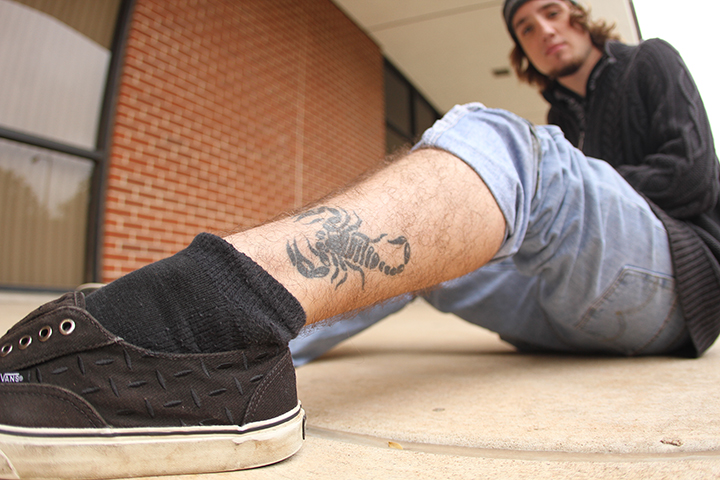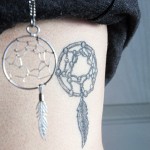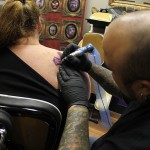
By Paula Ann Solis
Staff Writer
In a world of fleeting moments and memories, the 21st century has embraced an old idea to hold on to the past forever — tattoos.
Dr. Candi Cann, assistant professor in the Baylor Interdisciplinary Core, has researched in detail the many ways people are choosing to remember the dead. Specifically, she has studied the occurrence of makeshift roadside memorials, Internet memorials, car decal memorials and tattoos.
“People have a need to remember the dead and these memorials are a response to disappearing religious rituals surrounding the dead,” Cann said. “You see a lot of memorials instead of traditional religious funerals. You also see a rise in cremation, so you have the corpse disappearing from our everyday experience.”
Cann said funeral services were once held in a family’s home with the body in the house and, in some cultures, family members would wash the body before the burial. It was a hands-on experience and that experience was a way to grieve and let go, Cann said.
With funeral homes and cremation overtaking that once personal experience, people are left grasping for some last chance, a way to say, “I’m grieving,” Cann said. This is why Cann said tattoos are often sought as a substitute.
Cann said a person’s first tattoo is usually associated with death and for a young person, the first person to die in their life tends to be a grandparent or a friend.
Emily Atwood, a 2010 Baylor alumna, only has one tattoo, and it is a tribute to her grandfather who committed suicide her sophomore year at Baylor.
“I didn’t get to go home for the funeral because it was so far away, and I never got a feeling of closure,” Atwood said.
Every year after her grandfather’s death, Atwood would write the word “love” on her arm as part of the To Write Love On Her Arms campaign that serves as a reminder for people that they are loved and should not choose suicide as an option, according to the campaign’s website.
Atwood decided she wanted the word on her arm forever.
“I actually wrote it in my handwriting just below my wrist and they tattooed over it,” Atwood said. “It has been a really good reminder. It was difficult because he felt alone and unloved, which upsets me because I wish I could have told him I love him one more time.”
Cann said this type of memorial tattoo is not a phenomenon; the Bible speaks of memorial body markings in Leviticus 19:28. But now people are seen going one step further to be unique, Cann said. With the body as their canvas, some people are choosing to tattoo cremains into their skin so as to literally carry around the dead.
Zac “Lefty” Colbert, owner of the Waco tattoo parlor Infamous Ink, has been a tattoo artist for 19 years and said he has inked two tattoos with human cremains.
“Using ashes may seem new to us, but in history this isn’t a new concept,” Colbert said. “Forms of ash were added with ink for a long time. You have some people who are doing this to stay connected and then you have some people who are just trying to do the next most drastic thing.”
Colbert said for many people, a tattoo is the most honorable way to remember someone; the human body is the ultimate canvas. However, he said he always cautions people before getting tattoos in remembrance of a loved one. People need to look past their current state of grief and into the future, Colbert said.
One grieving widow asked Colbert for a tattoo of her late husband on her back. His advice was to wait and think it through but she wanted it right then, Colbert said. He gave her the tattoo and two years later she came back remarried and needed it removed.
That was an extreme case, Colbert said. For the most part people who get tattoos, especially memorial tattoos, do it in a manner similar to the way people collect photos in a scrapbook, Colbert said. It is not about how great the picture comes out or what other people think; it is the memory that one associates with the picture.
Burleson junior Garrett Gray said his tattoo, a Superman emblem on his right upper arm, might seem silly to some people but for him it is how he continues to remember his brother-in-law, Kenny Cotten, who suffered brain damage after multiple seizures and was ultimately declared brain dead.
“He was only 29,” Gray said.
Gray said he always wanted a tattoo but did not want it to be something meaningless. After Gray’s brother-in-law passed away two years ago, his sister had to cancel credit cards for her late husband. When the credit card service representative asked the security question “Who’s your favorite superhero,” they learned his answer was Superman. After that, Gray’s brother-in-law was affectionately called Superman and Gray knew what his first tattoo would be, a Superman emblem but instead of an “S” in the middle, it would be a “K” for Kenny.
“I never regret this tattoo and I don’t think I ever will because now, in a way, he’s always with me.”
Cann said tattoos and other non-religious memorials are not the solution to grief. She said they are a response to living in a country that does not allow for proper grieving. Other countries, such as canada and Australia, offer a federally mandated bereavement policy, Cann said. The United States does not.
According to Library of Congress, the Parental Bereavement Act of 2013 was introduced in February and would amend the Family and Medical Leave Act of 1993 by allowing eligible employees up to 12 weeks off from work after the death of a son or daughter.
However, the bill has been referred to a committee and since February has not been voted on or made any progress.
“Bereavement is a private industry,” Cann said. “People just don’t have the space and time to grieve. It’s a real problem.”
Cann is continuing her study of the grieving process in a place where space is seemingly endless and people seem to always have time to visit. The Internet. Her coming book, “Virtual Afterlives: Grieving the Dead in the 21st Century,” will examine how people are taking to the World Wide Web to say goodbye. It is an increasingly popular way to grieve, Cann said, without the physical permanence of tattoos.











